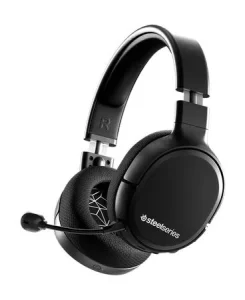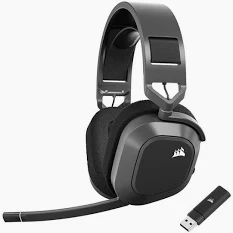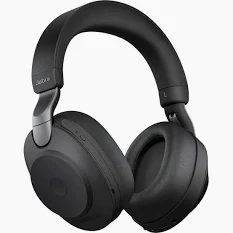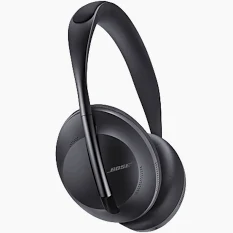I recently attended a workshop at my work and one of the things they mentioned about having a good converting trial was 1) Professionalism (dress, background, light, everything working), 2) Level adjustment (did you put them on the right level?) 3) Language clarification (did you explain things well). I’ve been working on my level adjustment skills, getting them on the right level, and now I’m trying to up my game in being professional, looking good, hair in place, even a jacket at times. I think what really annoys parents very deeply is, when those tech problems occur. Part of those problems are sound. If you can cover that base and have a good set of headphones to both hear and speak clearly, you will be ticking an important box so that everyone can hear well and you can have an excellent lesson. This post will outline what you need in a good set of headphones, and possible best headphones for online teaching.

Key Features to Look for in Headphones for Online Teaching
Here’s what to look out for in terms of sound quality and comfort:
Microphone Clarity and Noise Reduction
Good headphones start with a clear microphone. If your voice is muffled or cut off, students will struggle to follow along. Look for a model with a built-in mic that boasts noise reduction or noise suppression tech. This helps filter out background sounds—think barking dogs or clattering dishes—so your students hear just you, not your home soundtrack.
You don’t have to break the bank for solid audio, either. Many remote teachers have started with modest setups. If you’re curious about someone who made it work from scratch, check out this Interview with Terence on starting cheap. He proves that clear audio is possible on any budget.
Key microphone features:
- Boom-style mics (closer to the mouth, less background noise)
- Adjustable volume and mute controls
- Built-in echo cancellation
Long-Term Comfort and Ergonomics
Long online classes call for headphones you forget you’re even wearing. If your headphones press too tight or make your ears hurt, distraction is inevitable. Prioritize padding on both the ear cups and headband as well as lightweight materials like memory foam or soft leatherette.
What else helps? Adjustable headbands and swiveling ear cups. These little touches can make a big difference, especially for all-day wearers. Remember, discomfort can creep in quietly, only to hijack your focus later on.
Comfort must-haves:
- Soft and breathable ear padding
- Adjustable sizing for different head shapes
- Lightweight build for long hours
If you are looking for some pretty pastles, these are also available on Bash. You can get purples and creams with brands such as Typo and JBL.

Active and Passive Noise Cancellation
A noisy environment is par for the course in most homes. Noise cancellation is a teacher’s secret weapon. There are two main types:
- Passive noise cancellation: Physical features (like thick, cushy ear pads) block outside sounds.
- Active noise cancellation (ANC): Electronics create opposing sound waves to cancel out steady background noise, such as fans or traffic.
Not sure which suits you best? If your workspace is near a busy street or in a bustling household, ANC can make a world of difference. For quieter spaces, passive isolation might be all you need.
Battery Life and Charging Considerations
If you’re leaning toward wireless headphones, battery life is more than just a nice-to-have—it’s essential. Few things stall a class like a dying headset. Aiming for at least 15 to 30 hours of playtime per charge is a safe bet.
Fast-charging can rescue you on those days when you forget to plug in overnight. Look for headsets that offer a decent run time on a quick 10- or 15-minute charge break. Wired backup is a handy bonus if your model supports both.
Battery life tips:
- Double-check manufacturer claims against real-user reviews
- Consider headsets with auto-off features to save battery
- Keep a charging cable nearby for emergencies
Wired vs. Wireless: Pros and Cons
Choosing between wired and wireless comes down to what fits your style and needs. Here’s a quick comparison:
Wired headphones:
- No battery worries—just plug in and go
- Usually lighter and often cheaper
- Fewer compatibility issues
Wireless headphones:
- Freedom to move around your space
- Less clutter (no tangled cables)
- Some allow switching to a corded connection if the battery runs low
If you tend to walk around during lessons or like standing while teaching, wireless can be freeing. If you’re mostly at your desk, wired might save you some small daily hassles. Either way, choosing the right option makes teaching feel a little easier—something every online educator deserves.
Personally I’ve always had a wired headset so I don’t have to worry about this, but if you’re in the market for some of the non wired ones, you might need to take these considerations on board.
Top Headphone Recommendations for Online Teachers
Let’s break them down in terms of budget. I have included some quotes from online teachers, gathered from messages and Facebook groups.
Best Budget-Friendly Headphones
- Logitech H390 Wired Headset
- Pros:
- Reliable plug-and-play USB connection
- Noise-cancelling microphone for clear speech
- Soft, padded headband and ear pads
- Affordable price point, often below R600
- Cons:
- Wired only (no wireless option)
- Ear pads can get warm after long sessions
- This last one I got at Kloppers for R899. I see you can also get it R634 on Loot.
- Pros:


This one is my go-to. I actually have been going between this one and the Microsoft one. The Microsoft one has bigger pads for your ears to be covered (Possibly more comfort?) but I think I just liked these as they were smaller, less bulky and you could still see my earrings. I don’t think they are completely noise cancelling though. You would need to pair them with the Krisp app for best results.
Another teacher (Nicole) recommends the Logitech H111 Stereo Business Headset, which is even cheaper on Takealot for R169.


- JLab Go Work Wireless Headset
- Pros:
- Dual connectivity: Bluetooth or wired
- Clear, rotating boom mic
- Lightweight and foldable for portability
- Good battery life for a budget option
- Cons:
- Plastic build feels less sturdy
- No active noise cancellation
- R1119 on Takealot
- Pros:
- Razer Kraken X
- Pros:
- Lightweight build—easy to wear for long classes
- Soft memory foam ear cushions for comfort
- Bendable cardioid microphone for clear voice pickup
- Simple wired connection works with most devices (PC, Mac, mobile)
- Surround sound for more immersive audio experience
- Cons:
- Wired only, no wireless option
- No noise cancellation features
- Microphone is not detachable
- R899 on Takealot, Amazon and HiFi Corp R913 on Loot
- Pros:

“Razer Kraxen X headphones are amazing! They might be pricey but they are well worth the price!” Caroline Sparks “The sound and mic on these are amazing, but for my big head and ears it was very uncomfortable” Rico Fisher
Also check out: Razer Kaira Pro HyperSd PS5 Wireless Gaming Headset – R4899 on Bash.

A good budget headset gets the job done for everyday use, especially if you’re teaching from a quieter setting. If you’re looking for more inspiration to build your work-from-home starter kit, check out our post on parent productivity hacks for working from home.
Best Mid-Range Headphones
For those ready to upgrade, mid-range headsets offer a little extra comfort and sound quality without a luxury price tag. These usually feature better mics, longer battery life, and improved noise isolation.

- Plantronics (Poly) Voyager Focus UC
- Pros:
- Wireless with impressive range
- Comfortable memory foam ear cushions
- Noise-cancelling microphone with mute alert
- Up to 12-15 hours talk time
- Cons:
- Heavier than basic models
- I found it R3818 on Takealot, R2499 on First Shop
- Pros:
- Sony WH-CH720
- Pros:
- Active noise cancellation for work in noisier homes
- Soft, well-cushioned ear cups
- Strong battery (up to 35 hours)
- Sleek, lightweight design
- Cons:
- Built-in microphone isn’t as good for loud places
- No Bluetooth multipoint (one device at a time)
- I found it at the same price (R1999) at Incredible Connection, and HiFi Corp.
- Pros:


- Jabra Evolve 40
- Pros:
- Professional-grade noise-cancelling microphone for clear calls
- Lightweight and comfortable for all-day wear
- Plug-and-play USB or 3.5mm connection (wide device compatibility)
- Convenient inline controls for mute and volume
- Good passive noise isolation from padded ear cups
- Cons:
- Wired only (no wireless option)
- No active noise cancellation
- Design is basic compared to other models
- R1599 at First Shop
- “Excellent speakers and noise cancellation” Alister Morris.
- Pros:

- SteelSeries Arctis 1 Wireless
- Pros:
- Wireless and wired modes for flexibility
- Clear detachable boom microphone
- Lightweight design with soft ear cushions for comfort
- Good battery life (up to 20 hours)
- Works with PC, Mac, and mobile devices
- Cons:
- Microphone picks up some background noise in louder environments
- No active noise cancellation
- R2014 on Loot
- “I love my Steelseries as it is very comfortable, good sound and mic.” Rico Fisher
- Pros:

- Corsair HS80 MAX Wireless
- Pros:
- True wireless freedom with strong connection
- Broadcast-grade microphone for crisp, natural voice quality
- Comfortable memory foam ear cups suitable for long lessons
- Up to 65 hours of battery life (Bluetooth) and 24 hours (wireless dongle)
- Dolby Atmos spatial audio for immersive sound
- Multi-platform: works with PC, Mac, and mobile
- Pros:
- Cons:
- Bulkier than most non-gaming headsets
- Higher mid-range price point
- Gaming look may not suit all preferences
- R3299 on Computer Mania.
The Corsair HS80 MAX Wireless stands out for its long battery life, comfort, and excellent microphone clarity—making it a smart choice for teachers who want both reliability and flexibility in their setup.
I’m not sure which version of the Cosair these teachers had, but they were very happy with this brand:
“I just received my Corsair headphones today and they are super comfortable. Noise cancelling, over the ear and wireless. If you teach for long periods at a time, I would recommend getting a headset that is padded and comfortable. Corsair is more expensive but worth it. I would invest in a good quality pair.” Robyn Goodman
“I have a Corsair headset, it’s wireless and brilliant, though pricey!” Jenny Stoltz
These headsets are great for teachers who want to invest in tools that make your workday smoother and more comfortable, but don’t require all the bells and whistles.
Best Premium Headphones
If you spend hours online teaching or need robust features for a noisy home, premium headsets are the way to go. They combine top sound, the best microphones, and features like advanced noise cancelling, so you can focus no matter what’s happening in the background.

- Jabra Evolve2 85
- Pros:
- Superior microphone with up to 10 mics built in
- High-grade ANC to block distractions
- Over 30 hours battery life
- Can connect to two devices at once
- Cons:
- Bulky for smaller heads
- Pricey, but you get what you pay for
- R9999 at Takealot, R7899 at First Shop, R10999 on Amazon.
- Pros:

- Bose Noise Cancelling Headphones 700
- Pros:
- Industry-leading ANC filters out background noise
- Crisp, natural-sounding microphone
- Long-lasting comfort, even during marathon lessons
- Sleek and durable build
- Cons:
- Premium price
- Touch controls take practice
- Luggage warehouse R8990 (read the comments, not sure if it has a microphone), found “Quiet Comfort” ones at Incredible for R10099 and Makro for R5699.
- Pros:
Premium headphones are ideal when teaching is your day-to-day routine or you’re sharing your workspace with others. The peace and quiet they bring can feel like hitting the mute button on chaos.
Tips for Maximizing Audio Quality in Online Teaching
Do a Tech Check Every Day
Yes, you heard me. Allow at least half an hour to twenty minutes to avert disaster in your lessons. You might get to your computer and find that it won’t switch on. Or that the internet is not working. Or your headset is not registering your voice. Unplug things. Test again. I’ve found that plugging my headphones in another USB port often helps. I unplug and replug the internet connection. Turn on and off the whole computer. Keep trying different things until you find something that works.
Veteran teachers have also learnt: have a spare of everything! Backup internet. Backup headphones.
Proper Headset Positioning and Mic Adjustment
It’s surprising how much of a difference the way you wear your headset can make. You don’t need to be an audio engineer—just follow a few basics when you suit up for class.
- Position the ear cups so they fully cover your ears. This helps block out background noise and captures the full sound range.
- Adjust the headband so the headphones sit snugly, but not tight. Comfort matters during long sessions.
- Most important, set the mic about two fingers’ width from your mouth, slightly off to the side. This keeps your voice clear while cutting down on those sharp “p” and “s” sounds.
- Avoid touching or bumping the mic while teaching. Even a small nudge can boom across your students’ speakers.
Taking a moment to check your fit at the start of each session pays off with hours of crisp conversation and way less “Can you hear me now?” moments.
Adding an External Microphone
While a good headset mic often works for casual calls, external microphones lift your voice to a new level, which students appreciate more than you might think. USB desktop mics are plug-and-play—no fancy setup needed. They pick up your words clearly and can help reduce those awkward “Can you repeat that?” moments. Popular options include condenser microphones (great for crisp, rich voice sound) and dynamic microphones (which block out more background noise). I’ve got an extra external mic, and it really came in handy on one of those days when the headset wasn’t working.
Here’s why adding an external microphone can transform your online teaching:
- Better voice clarity: Your words sound warmer, less tinny, and more natural.
- Less background noise: Directional mics filter out distractions from all sides.
- Longer comfort: No worries about headset squeeze during multi-hour lessons.
If you often move your head or need to show materials on camera, a mic on a stand or a flexible boom arm means your sound stays consistent. Think of it as upgrading from fast food to home-cooked—everything just feels smoother.
Improving Room Acoustics
Even the best microphone stumbles when your voice bounces off bare walls or echoes around the kitchen. Improving the sound in your room doesn’t require a studio budget or professional renovations. Soft materials are your secret weapon.
Easy ways to soften your space:
- Lay down a rug or thick carpet to soak up sound.
- Add curtains or drapes (heavier is better) over windows.
- Stack a bookshelf with books and place it near your workspace.
- Tack up a few foam panels or even hang a blanket nearby.

If your desk is in an echo-prone area, try setting up a small divider with a folded blanket or a couple of couch cushions for instant sound treatment. Little changes go a long way and spare your students from that dreaded cavernous echo. I remember when I moved houses and I was teaching in an empty place for a few days just to use the internet, it sure had that echoing sound!
Useful Software Tools for Online Teachers
Your headphones and microphone handle the sound, but software is the control center. The right programs can cancel noise, boost your voice, and even help you run smoother classes.
Top tools online teachers swear by:
- Krisp or RTX Voice: Removes background noise like barking dogs or chatter.
- VoiceMeeter: Lets you mix sound from different sources and control volume in detail.
- OBS Studio: Records your lessons or adds visuals for live teaching sessions.
- ManyCam: Like Obs, you can use it to create visuals. I was scared to use it for a long time, but now I’m using it a lot. It makes the flashcards clearer on the screen.
- Built-in tools on Zoom, Teams, or Google Meet: Tweak their audio settings to reduce noise and test your mic before class.
Many teachers in the industry rely on Krisp as the go to software to get rid of background noise. You can use it for free for one hour a day. This really comes in useful for those unexpected noises. I have also used it, off and on, for those unexpected times when the gardener pitches up.
“With Krisp my gardener can mow then lawn right by my window with a petrol lawnmower and my students are none the wiser, I just have to crank my sound up to hear them.” Jenny Stoltz
A quick setup of these apps on your computer makes you sound more polished, whether you’re teaching kids, teens, or adults. Many teachers find one or two tools that make a noticeable difference in class quality and stick to them.

Choosing headphones that match your teaching style and home setup isn’t just about comfort or style. It’s about giving your students the clearest sound you can manage and giving yourself the ability to focus, even in a noisy home. The right headset takes a little stress out of every lesson, making your online classroom feel more professional and less like you’re battling your own equipment.
Wishing you a lot of joy and clear sounds in your lessons!
Which headset do you use? What have you found?
Disclaimer: This post was sponsored by Bash.
This post also contains a combination of AI and human work.



Leave a Reply